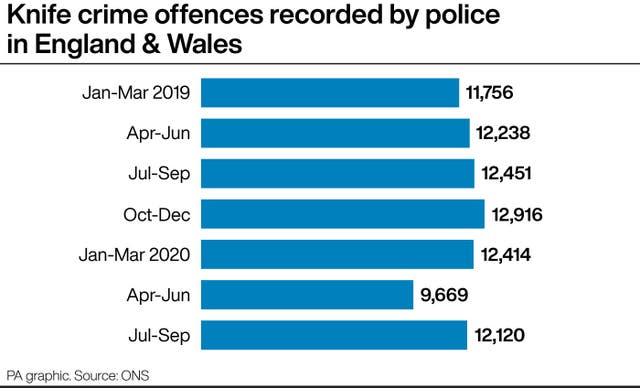Domestic abuse up 10% amid overall Covid-19 pandemic crime drop
The ONS said 842,813 domestic abuse-related offences were recorded by police forces in England and Wales in the year to September 2020.

Domestic abuse rose by 10% in a year, although overall crime was down during the Covid-19 pandemic, official figures show.
According to the Office for National Statistics (ONS), 842,813 domestic abuse-related offences were recorded by police forces in England and Wales in the year ending September 2020 – up from 769,611 the previous year.
It comes as domestic abuse commissioner Nicole Jacobs told MPs the current situation for victims during lockdown was “extremely serious”.
Safeguarding minister Victoria Atkins said the Government has been clear victims can leave their homes under current coronavirus restrictions.

“Throughout this pandemic, we have worked with the Domestic Abuse Commissioner and charities to protect those for who home is not a safe space.”
Total police recorded crime dropped by 6% to around 5.7 million offences, driven by substantial falls during April to June, particularly in theft offences, as the country spent most of the period under strict lockdown restrictions, a report published on Wednesday said.
But the results of a separate survey carried out by the ONS show the number of victims of crime in July to September 2020 returned to a similar level as in the pre-coronavirus period of January to March following a 19% drop in April to June.
National Police Chiefs’ Council lead for crime operations, Chief Constable Andy Cooke, said: “We have seen sustained falls in crime recorded through periods of national lockdowns as the public have largely stayed at home helping to stop the spread of the Covid virus.
“Many forces have stepped up their response to domestic abuse and have been innovative in light of new national and regional lockdowns.”
The police recorded crime figures show a 7% drop in firearms offences and a 3% dip in offences involving knives and sharp instruments in the 12 months to September last year.
Homicides, excluding the 39 Vietnamese migrants found in a lorry in Grays, Essex, in October 2019, increased 1%, from 655 to 659.
The ONS report said a 16% increase in recorded drug offences was driven by proactive police work in crime hotspots in April to June.
Stalking and harassment was also up 15% year on year, driven by a rise of stalking offences, from 23,543 to 64,265, although a change to Home Office counting rules from April 2018 may account for some of the increase.

“Data from the survey showed decreases in crime at the start of the pandemic, with rises seen over the summer months, specifically in theft, following the easing of lockdown measures, with overall crime now back at pre-lockdown levels of January to March 2020.
“There were also fluctuations in police recorded crime, but total recorded offences for July to September 2020 were below that seen in the same period in 2019.”
The number of police recorded offences increased by 20% between April to June 2020 and July to September 2020 following a 15% decrease in the previous quarter, although the 1.5 million offences in July to September was 5% lower than the 1.6 million in the same period in 2019.
According to the ONS survey, there was a 47% rise in the number of theft victims in July to September compared with April to June, up to 1.2 million – the same as before coronavirus in January to March.
The report said an annual 3% drop in knife crime was largely down to a decrease in April to June, where offences fell 22% from 12,414 to 9,669, compared with the previous quarter, before rising 25% to 12,120 in July to September – still 3% lower than the same period in 2019.
Chief executive Javed Khan said: “The coronavirus pandemic and lockdown restrictions have artificially depressed knife crime figures, which were at an all-time high before Covid-19 struck.
“During the first lockdown from April to June last year, offences plummeted by 22%, but rose by 25% again in July to September, giving us an idea of what might erupt once restrictions are lifted and life begins to return to normal.
“Children and young people have spent months out of school and away from their support networks, leaving many vulnerable to exploitation and control by criminal gangs who have seized on the disruption.
“With rising unemployment and poor job prospects, some young people are finding it hard to believe in a positive future, and see no alternative but to turn to a dangerous way of making money, carrying knives to protect themselves.”
Meanwhile, separate figures released by the Home Office on Wednesday show the proportion of crimes in England and Wales resulting in a charge or summons was 7.3% in the 12 months to September 2020 – the same as the previous year and a slight rise on a record 12-month low of 7% in the year to March 2020.





